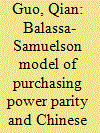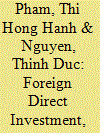|
|
|
Sort Order |
|
|
|
Items / Page
|
|
|
|
|
|
|
| Srl | Item |
| 1 |
ID:
095936


|
|
|
|
|
| Publication |
2010.
|
| Summary/Abstract |
Our principal purpose here is to assess the extent to which both the official and black market exchange rates for the Chinese economy exhibit compatibility with the Balassa-Samuelson model over the period from 1985 to 2006. We employ annual measures of inflation and industry input on an aggregated, disaggregated and sector basis, all of which have been especially constructed for this study. Both the time series and panel cointegration tests applied to this data are generally inconsistent with the prediction of the Balassa-Samuelson model that the tradable goods sector is compatible with purchasing power parity. However, our analysis also shows that other predictions of the Balassa-Samuelson model - most notably that there will be a strong long-run relationship between the real exchange rate and the relative productivity differential between China and the U.S. - does hold up for the Chinese economy. Moreover, the black market exchange rate appears to be more consistent with the predictions of the Balassa-Samuelson model than the official exchange rate.
|
|
|
|
|
|
|
|
|
|
|
|
|
|
|
|
| 2 |
ID:
148694


|
|
|
|
|
| Summary/Abstract |
China, as an important source country in the global value chain, especially in the East Asian production networks, has exerted significant influence on Sino–Japanese trade fluctuations. This paper explores the real factors that lead to the fluctuations in Sino–Japanese trade. Using the Hodrick–Prescott filter technique and OECD–WTO Statistics on Trade in Value Added from 1995 to 2011, the impact of the changing comparative advantage between the two countries is also examined. The empirical results indicate that determinants of the fluctuations in Sino–Japapese trade include changing comparative advantages, the volatility of the real exchange rate and quite a few external shocks. Some policy suggestions are put forward in regards to the stability of trade between the two countries.
|
|
|
|
|
|
|
|
|
|
|
|
|
|
|
|
| 3 |
ID:
126935


|
|
|
| 4 |
ID:
110507


|
|
|
|
|
| Publication |
2011.
|
| Summary/Abstract |
Since China's transition to a market economy, the labour productivity growth has been dramatically rapid, in particular since 1994. This speeding up has been accompanied by the reverse of the exchange rate policy of China, which has strongly depreciated its currency before 1994, and then either appreciated or stabilized it. The theoretical arguments suggesting several kinds of real exchange rate impact on labour productivity are developed. An econometric model is then proposed and estimated, using panel data for the twenty-nine Chinese provinces and for the period from 1986 to 2007. The econometric results show that the appreciation of the real exchange rate had a favourable effect on the labour productivity growth, leading to a kind of virtuous circle: the real appreciation of the currency boosts the growth of labour productivity while, according to the Balassa-Samuelson effect, productivity growth tends to push up the real appreciation. Moreover, this favourable effect is stronger in inland provinces than in coastal provinces, contributing to a minimizing of the gap between inland and coastal provinces.
|
|
|
|
|
|
|
|
|
|
|
|
|
|
|
|
| 5 |
ID:
078038


|
|
|
|
|
| Publication |
2007.
|
| Summary/Abstract |
The impacts of the real exchange rate on employment and its channels are investigated. A real appreciation, (1) by switching factors from workers to imported inputs (technological channel), (2) by decreasing exports (export volume channel), (3) by exerting pressure on efficiency improvement (efficiency channel), exerts an effect on employment. Using the panel data of the 29 Chinese provinces for the period 1993-2002, the econometric results show statistically significant negative effects of the real appreciation of the renminbi on manufacturing employment. The three channels are statistically significant, the technological channel being the most important
|
|
|
|
|
|
|
|
|
|
|
|
|
|
|
|
| 6 |
ID:
072607


|
|
|
|
|
| Publication |
2006.
|
| Summary/Abstract |
This paper investigates the RMB exchange rate from a long-run viewpoint. Whether China's rapid economic growth brought about real exchange rate appreciation between 1975 and 2002 is empirically examined, based on a supply-side model, the Balassa-Semuelson Hypothesis (BSH). The same test is conducted on Japan, Hong Kong, Korea, Malaysia, Singapore, Thailand, the Philippines, Indonesia and India. Our result indicates that the BSH only exists where the industrial structure has been upgraded and the economy has been successfully transformed from an agricultural economy to a manufacturing economy. Interestingly, China, among those where the BSH does not present, appears to be upgrading its industrial and trade structure. We then try to answer the question of why past rapid growth has no significant relationship with the RMB real exchange rate and what factors are underlying the trend of the RMB real exchange rate. We expect an appreciating trend of RMB real exchange rate in the foreseeable future, presuming that China's industrial upgrading process continues and the factors pertaining to the BSH's prediction, such as rise of wage rates in both tradables and nontradables, become more significant.
|
|
|
|
|
|
|
|
|
|
|
|
|
|
|
|
|
|
|
|
|